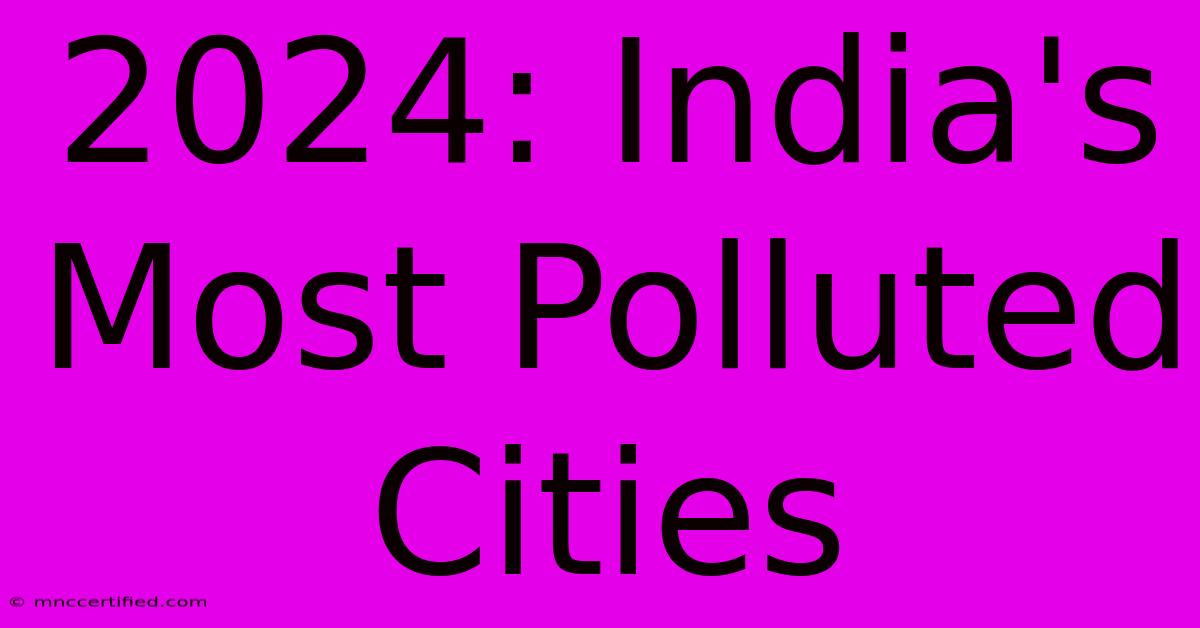2024: India's Most Polluted Cities

Table of Contents
2024: India's Most Polluted Cities: A Growing Concern
Air pollution remains a significant and growing challenge for India. While the country is making strides in economic development, the environmental cost, particularly in its major cities, is alarming. This article will explore the cities consistently ranking among India's most polluted in 2024, analyzing the contributing factors and potential solutions. We'll delve into the health impacts, government initiatives, and individual actions needed to combat this pervasive issue.
The Top Contenders: Identifying India's Pollution Hotspots in 2024
Pinpointing the most polluted cities in 2024 requires access to real-time data constantly updated by organizations like the Central Pollution Control Board (CPCB) and IQAir. However, based on historical trends and ongoing reports, several cities consistently feature near the top of pollution indices. These usually include, but aren't limited to:
-
Delhi: Delhi's notorious air pollution is largely attributed to vehicular emissions, construction dust, industrial activities, and seasonal factors like stubble burning in neighboring states. The city frequently experiences periods of dangerously high PM2.5 levels.
-
Mumbai: While not as consistently severe as Delhi, Mumbai's pollution levels are a serious concern, driven by traffic congestion, industrial emissions, and construction. Its high population density exacerbates the problem.
-
Kolkata: Kolkata's air quality is significantly impacted by vehicular emissions, industrial pollutants, and construction. The city's geography and meteorological conditions can also contribute to trapping pollutants.
-
Other Major Cities: Other metropolitan areas like Bengaluru, Chennai, Hyderabad, and Ahmedabad frequently experience high pollution levels, although their ranking fluctuates based on seasonal variations and specific events.
Understanding the Pollution Index: PM2.5 and AQI
Understanding air pollution requires familiarity with key metrics. PM2.5 refers to fine particulate matter, microscopic particles that penetrate deep into the lungs and cause significant health problems. The Air Quality Index (AQI) provides a numerical scale to assess air quality, with higher numbers indicating worse conditions. Regularly checking the AQI for your city is crucial to understanding the current pollution levels.
The Causes of Air Pollution in Indian Cities: A Multifaceted Problem
The causes of air pollution in India's cities are complex and interconnected:
-
Vehicular Emissions: Rapid motorization and a growing number of vehicles on the roads contribute significantly to air pollution, particularly in densely populated urban centers.
-
Industrial Emissions: Industrial activities, especially those lacking adequate emission control measures, release harmful pollutants into the atmosphere.
-
Construction Dust: Ongoing construction and demolition activities generate substantial amounts of dust, adding to the particulate matter in the air.
-
Stubble Burning: The practice of stubble burning in agricultural fields, particularly in the northern states, contributes heavily to Delhi's winter pollution.
-
Waste Management: Inefficient waste management practices, including open burning of garbage, contribute to air pollution.
-
Meteorological Conditions: Favorable meteorological conditions, like temperature inversions, can trap pollutants near the ground, leading to higher concentrations.
Mitigating the Crisis: Solutions and Initiatives
Addressing India's air pollution crisis requires a multifaceted approach involving government policies, technological advancements, and individual actions.
-
Government Regulations: Strengthening emission standards for vehicles and industries, coupled with stricter enforcement, is crucial.
-
Renewable Energy Transition: Promoting the use of renewable energy sources like solar and wind power can reduce reliance on fossil fuels.
-
Improved Public Transportation: Investing in and expanding public transportation systems can reduce the number of private vehicles on the roads.
-
Sustainable Construction Practices: Implementing measures to reduce dust emissions from construction sites.
-
Waste Management Improvements: Improving waste management infrastructure and promoting waste segregation and recycling.
-
Public Awareness Campaigns: Raising public awareness about the health impacts of air pollution and encouraging individuals to adopt sustainable practices.
The Health Impact: A Silent Killer
The health consequences of air pollution are severe, leading to respiratory illnesses, cardiovascular diseases, and even premature mortality. Children and the elderly are particularly vulnerable. The economic burden of treating pollution-related illnesses is substantial.
Conclusion: A Collective Responsibility
Combating air pollution in India's cities requires a collective effort from the government, industries, and individuals. By implementing effective policies, promoting sustainable practices, and raising public awareness, we can work towards cleaner and healthier cities for all. The situation is serious, but with concerted action, a significant improvement in air quality is achievable. Continued monitoring, data analysis, and transparent reporting are vital to track progress and inform future strategies. The fight for cleaner air is a fight for a healthier India.

Thank you for visiting our website wich cover about 2024: India's Most Polluted Cities. We hope the information provided has been useful to you. Feel free to contact us if you have any questions or need further assistance. See you next time and dont miss to bookmark.
Featured Posts
-
Astros Announce Daikin Park Name Change
Nov 19, 2024
-
Will Insurance Cover Mole Removal
Nov 19, 2024
-
Podiatrist Cost Without Insurance
Nov 19, 2024
-
Commercial Charter Boat Insurance
Nov 19, 2024
-
Errors And Omissions Insurance Nc
Nov 19, 2024